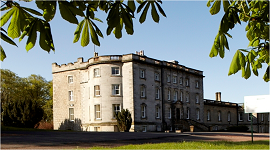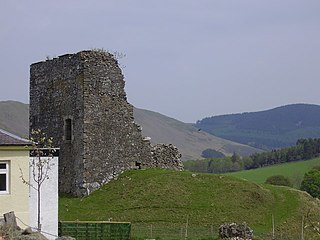
Wishaw is a large town in North Lanarkshire, Scotland, on the edge of the Clyde Valley, 15 miles (24 km) south-east of Glasgow city centre. The Burgh of Wishaw was formed in 1855 within Lanarkshire. It formed a joint large burgh with its neighbour Motherwell from 1920 until its dissolution when Scottish local authorities were restructured in 1975, and was then in Motherwell district within the Strathclyde region until 1996. The town is part of the Motherwell and Wishaw constituency. It has the postal code of ML2 and the dialling code 01698.

Carluke is a town that lies in the heart of the Lanarkshire countryside in South Lanarkshire, Scotland, 4+3⁄4 miles northwest of Lanark and 4+1⁄4 mi (7 km) southeast of Wishaw.

Anfield Cemetery, or the City of Liverpool Cemetery, is located in Anfield, a district of Liverpool, Merseyside, England. It lies to the northeast of Stanley Park, and is bounded by Walton Lane to the west, Priory Road to the south, a railway line to the north, and the gardens of houses on Ince Avenue to the east. The cemetery grounds are included in the National Register of Historic Parks and Gardens at Grade II*.

The Hub is a public arts and events building in the centre of Edinburgh, Scotland. Located at the top of the Royal Mile, it is a prominent landmark as its tall Gothic spire is the highest point in central Edinburgh, and towers over the surrounding buildings below Edinburgh Castle.

James Gillespie Graham was a Scottish architect, prominent in the early 19th century.

Cambusnethan is a large village and suburb on the eastern edge of Wishaw, North Lanarkshire in Scotland. It is approximately 1.5 miles (2.4 km) long, straddling both sides of the A722 on a hill overlooking Wishaw.

Coltness is the largest suburb of the town of Wishaw, North Lanarkshire, Scotland. The 2001 census indicated a population of almost 4,500.

The South Calder Water, known locally as "The Cawder", or simply "Calder", is a river in Scotland. It runs west from the high plateau between Shotts and Fauldhouse to its joining with the much larger River Clyde.

Gowkthrapple is a small neighbourhood of Wishaw, Scotland, situated around 3⁄4 miles (1.2 km) from the town centre. The name "Gowkthrapple" is a Scots compound word made up of "gowk", meaning "idiot" or "cuckoo" and "thrapple", meaning "throat" or "strangle". One theory of how the community gained its name is that there was a woodland here which was notable for cuckoos. Gowkthrapple can be entered off of Castlehill Road which runs the length of the estate. Formerly an industrial area, associated with the Pather Iron and Steel Works and then Smith's clock factory, which opened in 1951. This closed in the 1970s, although the premises remain standing on Smith Avenue and have been reused as Garrion Business Park. In mid 2020, Gowkthrapple had an estimated population of 1,040.
Craigneuk is a suburb of Wishaw, North Lanarkshire, Scotland. The original village of Craigneuk was located in the area where Meadowhead Road meets the A721 at Craigneuk Street. It was originally part of Dalziel parish, along with the other rural weaving villages of Flemington, Motherwell and Windmillhill. Craigneuk village was located close to the boundary with Cambusnethan parish.

Murdostoun is an estate in North Lanarkshire, Scotland, which includes a castle, which lies on the South Calder Water near the village of Bonkle in the parish of Shotts, North Lanarkshire, Scotland. The name Murdostoun was derived from the words Murthock and Toun which meant dwelling of Murthock. Murdostoun can refer to the ancient barony of the Scott and then the Inglis clan, the castle built by the Scotts or a bridge over the South Calder Water.
Netherton is a southerly suburb of Wishaw, which can be entered from Netherton Road, which runs easterly from Pickering's Corner to the Cherry Tree public house, spanning the full length of the suburb. Alternatively, Netherton can also be entered from Netherton Street, which runs from the Heathery roundabout to Netherton Cross. Netherton is bordered by Gowkthrapple, Craigneuk, Muirhouse and the River Clyde.
Thomas Lainson, FRIBA was a British architect. He is best known for his work in the East Sussex coastal towns of Brighton and Hove, where several of his eclectic range of residential, commercial and religious buildings have been awarded listed status by English Heritage. Working alone or in partnership with two sons as Lainson & Sons, he designed buildings in a wide range of styles, from Neo-Byzantine to High Victorian Gothic; his work is described as having a "solid style, typical of the time".

Castlehill Tower, also known as Castle Hill of Manor, is a ruined oblong tower house dating from the end of the 15th century, situated in the parish of Manor, 1.5 miles (2.4 km) from Kirkton Manor, Scottish Borders, Scotland.
South Wishaw Parish Church is a parish church of the Church of Scotland, serving the southern area of Wishaw, North Lanarkshire. It is within the Church of Scotland's Presbytery of Hamilton.

Nenthorn is a parish and hamlet in the south of the historic county of Berwickshire in the Scottish Borders area of Scotland. It is included in the Floors, Makerstoun, Nenthorn and Smailholm Community Council area, which also includes the parishes of Makerstoun and Smailholm. It was included in the former Roxburgh District of Borders Region, by the Local Government (Scotland) Act 1973, from 1975 to 1996.

Architecture in Bathurst, a regional city in the state of New South Wales, Australia includes a unique collection of architecture. This architecture reflects Bathurst's history from colonial through to recent times, with many examples remaining intact. Historical buildings range from workers cottages, terrace houses, mansions, slab huts, industrial, commercial buildings and grand civic structures.

Cleland (Old) railway station was opened in 1867 on the Cleland to Morningside Junction line that had opened in 1864. The extension of the Cleland Branch on the line of the old Wishaw and Coltness Railway joined the Coltness Branch section of the Wishaw and Coltness Railway via the Coltness Ironworks and then as stated it continued to Morningside.

Wishaw House was a large mansion located in Wishaw, Scotland. Once the family seat of the Belhavens and Hamilton family, the mansion was abandoned by the 20th century and was demolished, now nothing more than a ruin in the woodland by the South Calder Water.



















